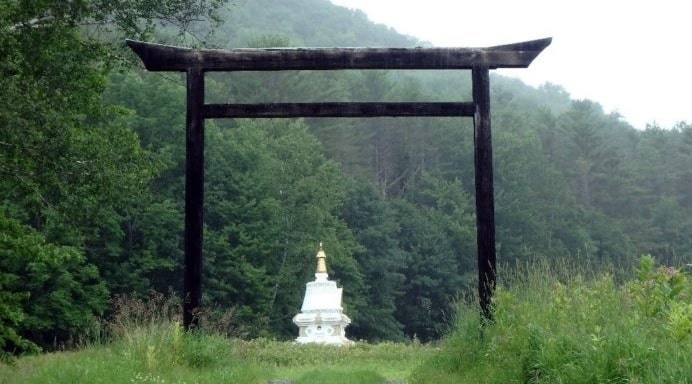
During the Vajradhatu era, in general people received the Werma Sadhana transmission after having completed all levels of Shambhala Training and after having received the stroke and lungta transmissions. In the beginning, there was no Warrior’s Assembly, Rigden ngöndro, or Rigden abhisheka. Students received the Werma transmission as part of a program called “Kalapa Assembly.” The Dorje Dradül gave dozens of talks at those advanced programs, which were edited and published as the Collected Kalapa Assemblies 1978 – 1984. Students studied that material intensively. While it was possible to receive the Werma Sadhana without vajrayana transmission, most of those who received the practice from Trungpa Rinpoche during his lifetime were sadhakas, advanced vajrayana practitioners, many of them practitioners of the Vajrayogini Sadhana.
Historical overview of the Werma Sadhana as taught by the Vidyadhara, Dorje Dradül of Mukpo
The Dorje Dradüldiscovered The Scorpion Seal of the Golden Sun: The Shorter Text in September 1979 in Vancouver, British Columbia. It was translated by the Nalanda Translation Committee in October at the Kalapa Assembly held in Big Sky, Montana. There was an indication of a longer text yet to come.
He discovered The Scorpion Seal of the Golden Sun: The Full Text in the Spring of 1980, during the Vajradhatu Seminary in Lake Louise, Alberta. This terma text provides the pith of the Werma Sadhana, including the front and self visualization texts. There is much detail about the abhisheka required for the retreat practice described in the shorter Scorpion Seal text.
In October 1980, during a retreat in Patzcuaro, Mexico, the Dorje Dradülcomposed The Roar of the Werma: The Sadhana of the Warrior in order to practice the teachings contained in the Scorpion Seal termas. This text is more commonly known as the Werma Sadhana. It was translated soon after his return to Boulder in late October.
On December 1 of that year, while teaching a seminar at the Keltic Lodge in Ingonish, Nova Scotia, the Dorje Dradülgave the first reading transmission (lung) for this text and its practice to all the advanced students who were present, and he bestowed the text upon them.
To begin, the Werma Sadhana was to be practiced on the 9th, 19th, and 29th days of the lunar calendar, which are regarded as days specifically effective for protector practices and, as the Dorje Dradülsaid, “celebration days for the dralas.” He initially discouraged people from doing daily or solitary retreat practice. In 1984, before entering a year-long retreat at Mill Village, Nova Scotia, he began to encourage Lodge members to engage in daily and/or retreat practice, especially if they had done intensive Vajrayogini sadhana practice. He permitted tantrikas engaged in the Kagyu ngöndro practice to do the Werma Sadhana practice daily after completing guru yoga.
As explained in the full Scorpion Seal terma, there is a recitation requirement of accomplishing 100 million mantras, after which one could request the abhisheka detailed in the terma and then enter the four-week solitary retreat. In 1982, the Dorje Dradülencouraged practitioners to keep track of their mantra recitations, though he was not yet certain that the 100 million number would be required. After further consideration over the next year or so, he affirmed that what it says in the terma should be followed and that he was not going to modify that at all.
In 1984-85, during his year-long retreat at Mill Village, Nova Scotia, he told Sherab Chödzin that he thought that 500,000 recitations of the Werma Sadhana mantra might be enough, since he wanted to use the Scorpion Seal retreat to inspire people, and he indicated that he would lead this retreat. We don’t believe this was ever communicated generally, nor did he ever confer this abhisheka or lead such a retreat.
At 1981 and 1982 Kalapa Assemblies, the lung for the Werma Sadhana was conferred by the Dorje Dradül himself. Werma practice became a major focus for the sangha, and was both conferred and explained at Kalapa Assemblies, where practice sessions were conducted daily. In 1984 the Dorje Dradül instructed the Dorje Loppön Lodrö Dorje to give the lung to the assembly, and from then on other senior teachers gave it in various situations.
During the lifetime of the Dorje Dradül, the majority of his warrior-students were tantrikas or vajrayana practitioners, most of whom had completed the Kagyü ngöndro and were engaged in Vajrayogini practice as their main meditative focus. This resulted in the following comment made by him at the 1982 Kalapa Assembly (Collected Kalapa Assemblies 1978-1984, page 438):
The drala [Werma Sadhana] practice is like the sharp edge of the sword blade which deals with day-to-day life already, automatically. The Vajrayogini practice is like the other edge of the sword blade, which carries the weight so that the sharp edge can cut. It’s like the two sides of a coin.
While nearly all the Werma practitioners were tantrikas, engaged either in the Kagyü ngöndro or Vajrayogini practice, there were a small but growing number of non-Buddhist Werma practitioners, and the Dorje Dradülwas particularly overjoyed about that. The Shambhala path was meant to be all-inclusive in terms of world spiritual-contemplative traditions, not just for Buddhists nor vajrayana practitioners. The author of the Werma Sadhana, not itself a terma but rather drawn from the two Scorpion Seal termas, considered it to be a Shambhala practice, not a Buddhist practice, though it was inspired by Buddhist teachings.






